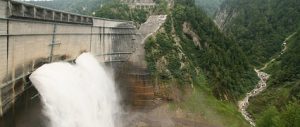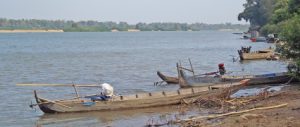In Japan, the government has only recently reached the point where it is finally willing to recognise the causal relationship between reservoirs and landslides.
The Ōtaki Dam in southern Honshu was completed in 1977 after more than two decades of construction, the expenditure of 23 billion yen (US$251million), and the relocation of 475 homes. After years of delay, workers began to fill the reservoir up with water in March 2003.
The following month, a slope to the right of the dam in an area known as Shiroya began to creep downward. “In the middle of the village, a crack appeared in the ground, and it was clear that it was very deep,” says president of the neighbourhood community association, 75-year old Isaka Kanshiro.
Isaka recalls that, before the dam was constructed, the government determined that the area was in danger of landslides and researchers recommended that all the households in the village be moved to a safe location.
But this did not happen. “Government officials decided that the village did not need to be moved if certain measures were taken to prevent the land from sliding,” says Isaka. “But once they began to design the dam, they decided that it would be okay and simply drove some piles into the ground at a depth of 20 metres. This was like beating the air. When they started filling up the reservoir and the water level rose, of course the land slid.”
Soon afterwards, the construction ministry, now part of the Ministry of Land, Infrastructure, Transport and Tourism, recognised that the dammed water was the cause of the landslide. In May 2003, it created a committee to investigate the fissure in the Shiroya area, which cited other examples of reservoirs triggering landslides such as Ōdo Dam, on the southern Japanese island of Shikoku in 1982 and Vajont Dam in Italy in 1963. The Construction Ministry was clearly aware of dam-caused landslides.
There is evidence in parliamentary records that the government knew about the danger of landslides at Ōtaki Dam. During a session of the Lower House Budget Committee in March 1990, questions were raised about sections of a local soil survey report that indicated there was a possibility of landslides.
Even though Italian engineers were aware there was a danger of a mountain collapsing into a newly-created reservoir behind the Vajont Dam, once the dam was completed and the reservoir filled, a massive landslide occurred, creating a tsunami that swept downstream and took the lives of 2,000 people. Likewise, the damage at Shiroya happened because the government ignored survey results and the concerns of residents and concentrated on cutting costs while continuing to push forward the project.
MLIT has now emptied the reservoir and is carrying out projects to prevent further landslides. Truly, the criticism that public works projects are “born small but grow huge” aptly fits landslide prevention measures. In August 2008, the government amended its dam legislation, extending construction projects to 2012, and allocating funds of 364 billion yen (US$4 billion). Projects that were supposed to take 15 years will now take half a century and cost 16 times more than originally expected.
Landslide prevention measures at JWA’s Takizawa Dam in central Honshu have continued for three years. The first landslide occurred on November 2, 2005. The previous month, while the reservoir was being filled, a slope 1.5 kilometres above the dam shifted one centimetre and fissures appeared in four separate spots. Landslide prevention procedures were conducted for nine months at a cost of 3 billion yen (US$32.8 million).
In August 2006, soon after those measures completed, workers began to fill the reservoir again. In May 2007, the slope right next to the one that had been strengthened collapsed. Half a month later, the slope — now 90 metres wide, 27 metres deep, and 15 metres long — slid further. JWA had taken preventative measures in no less than 40 different places. Yet this was insufficient.
Prevention measures continued and, in August 2007, another attempt was made to fill the reservoir. This time, workers were able to fill it to capacity but, as they began to lower the water in April 2008, a crack was discovered in a city road near the reservoir bank. As the water level continued to decline, other fissures appeared. Even when the water level was maintained, the land continued to slump. It was an obvious disaster.
Could this all have been avoided? A JWA official reported: “In November 2003, a public works committee at the Kanto Region Development Bureau evaluated the cost-benefit of the landslide prevention measures and recommended that we ‘continue’. We did not arrive at this decision internally.” But an investigation of the committee’s minutes reveals that there was not a single geologist among its 12 members. No one takes responsibility, no one makes rational decisions and tax monies continue to be wasted.
There may be nothing as perverse as building a dam in an area that you know is susceptible to landslides. Japan’s Landslide Prevention Law places limits on “increasing, attracting, or retaining ground water” above areas deemed vulnerable to landslides. Dams constructed in such areas present a stark violation of this law. One example of this is the JWA’s Shimokubo Dam on the Kanna River, the westernmost branch of the Tone River.
Just below the dam is an area that was designated a protected zone in 1962 because landslides had occurred there in 1910, 1938, and 1947. Despite this, the Shimokubo Dam was constructed there in 1968.
About two years after the dam was completed in 1991, a concentrated downpour triggered a huge landslide, which destroyed 40 homes. Cracks and bumps appeared in other houses and roads. A motorway was completely closed for six days, and one lane was closed for a further 565 days. The following year, heavy rains intensified the landslide problems and, in 1995, the area was declared one of 12 “landslide zones under direct control of the central government”.
These problems have transformed the area into one of the country’s largest public works projects, currently expected to complete in 2025 and to cost 38 billion yen (US$415 million). Though the project is under central government control, the prefecture is expected to bear one-third of the cost.
What is the relationship between the dam and the landslides? The hypothesis that the reservoir, which seeps into the groundwater causing its level to rise, is a contributing factor seems reasonable. However, officials are unwilling even to investigate this relationship. Planning officials at the Kanto Region Development Bureau appear to have been unaware that a landslide zone under the direct control of the central government lay just below the Shimokubo Dam. Perhaps they would like to deny any relationship between the dam and landslides, but they should at least investigate the possibility and the risks involved.
Even as questions about the possibility of landslides go unanswered, the Asakawa Dam in central Honshu – a venture that was once cancelled – is moving ahead. The site of the project is on the south-west side of the one-time volcano Mount Iizuna, located between the epicentre of the 7.4 magnitude Zenkoji Earthquake, which rocked the area in 1847, and the Mount Chizuki Landslide, that occurred in July 1985. All three locations lie on the western edge of the Nagano Basin, where volcanic tuff is widely distributed.
One of the first people to realise the danger of the Asakawa Dam was Uchiyama Takurō, who was forced to relocate his house by the Chizuki Landslide from a hill on the right side of the Asakawa River to one on the left side. He decided to build a pond on his new property, but was told that he could not because the area was susceptible to landslides. Why then, he wondered, is a dam being planned in this area? After investigating, Uchiyama discovered workers had been drilling bore samples for twenty years and had failed to find a site that was appropriate for a dam.
Suddenly, however, the project began to accelerate. In preparation for the 1998 Nagano Winter Olympics, the prefecture decided it needed a road to replace a toll road that had been devastated by the Chizuki Landslide. The prefecture, which was short of money, combined the road with the Asakawa dam project as a last ditch measure to obtain additional funding. In this way, the dam project was restarted.
In 2000, Uchiyama led newly-elected prefectural governor Tanaka Yasuo on a tour of the dam site. He informed him that the current location was the fourth or fifth that had been proposed and that it had initially been abandoned as inadequate. By the end of the day, Tanaka had decided to pull the plug on the project.
But in June 2007, a number of prefectural assembly members suggested that another investigation be conducted into the geology of the proposed site. In response, the director of the construction department declared that “sufficient surveys had been conducted” and that the prefecture would proceed “using the best designs and workmanship”. Such statements have been heard before in the cases of the Ōtaki Dam and the Takizawa Dam.
When dams are constructed in areas with volcanic geology or that have been designated as landslide prevention areas, they often lead to serious human and economic costs. When will the government learn from all these examples that “using the best designs” will not be enough? Just what will it take for officials to cancel dangerous dam projects?
Masano Atsuko is a journalist specialising in environmental issues.
An earlier version of this article appeared in Sekai in December 2008 and was later published as “The Immense Cost of Japanese Dams and Dam-related Landslides and Earthquakes,” The Asia-Pacific Journal, 1-2-10, January 4, 2010, translated from Japanese into English by Aaron Skabelund. It is used here with permission.
Homepage image shows one of the many landslides triggered by the Iwate-Miyagi Nairuku Earthquake, which struck northern Honshu in June 2008.



